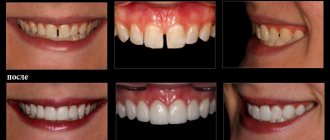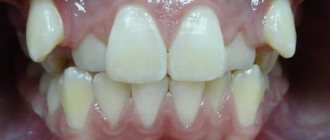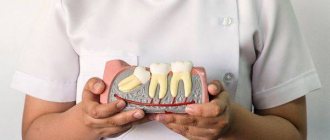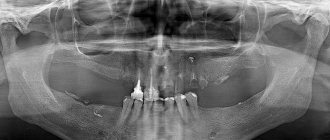Home / Articles / Impacted fang
It has long been known that teeth can fall out too early and humanity is trying to combat this problem in every possible way. Recently, another problem of a slightly different nature has appeared - teeth began to erupt ahead of time, and this leads to another problem - an impacted tooth. Most often, this happens in childhood, while adults are faced with impacted teeth at the time of the eruption of the so-called “wisdom teeth” or eights. What is an impacted molar or canine tooth, why does it need close monitoring, and should it be removed?
What are malocclusions?
Types of bites
There are several malocclusions, depending on the position of the teeth relative to each other:
- Diastema. A small gap between the front incisors of the upper jaw. It is common in children, but usually goes away by adulthood. But for some, the diastema does not disappear even after the final change of bite, and as a result remains with the person for life.
- Tremes. Small spaces between all other teeth. Also common in children, but sometimes do not go away by adulthood.
- Crowding. With this anomaly, the teeth creep on top of each other due to the fact that there is not enough space for them in the jaw. Often, crowding appears late, when a person begins to erupt in numbers of eights - they press and squeeze the remaining teeth in the row.
- Transposition or dystopia. Teeth erupting in atypical places - above or below the dentition, or even on the palate. This anomaly occurs if there is too little space in the dentition, or if the rudiments of the teeth are not formed correctly. Sometimes supernumerary teeth, that is, extra teeth caused by genetic abnormalities, become dystopic.
- Distal bite. Reduction in the size of the lower jaw, due to which the lower teeth are located far behind the back ones, and the upper ones often protrude forward. This pathology is especially widespread among Europeans and Russians.
- Mesial bite. In this case, the situation is reversed - the upper teeth are hidden behind the lower teeth. This is often accompanied by crowding in the upper jaw, and on the contrary, tremors appear in the lower jaw.
- Open bite. A situation where the teeth do not close together and a gap forms between them. An open bite can occur on both the front and back teeth. It is rare, mainly due to unfortunate heredity, mouth breathing or thumb sucking.
- Deep bite. The upper teeth overlap the lower teeth too much, sometimes even resting on the mucous membrane of the lower jaw.
- Crossbite. The teeth do not close normally, but cross each other, randomly overlapping each other.
These pathologies can exist either separately or together. Sometimes they are practically invisible, and a person may not even know that the bite is broken, although in fact the anomaly exists and requires treatment.
What are each type of teeth?
Let's take a closer look:
- The incisors are the front teeth in the middle of the jaw. They only have one root. They have an external convex and internal, slightly concave surface, as well as small tubercles at the base. They are intended primarily for tearing food into separate pieces (biting off). Due to their sufficient weakness, they are practically not suitable for chewing.
- The canines follow in a row behind the incisors, located in the corners of the jaws. They are equipped with the longest root and crown, so they are quite strong.
- Premolars are located behind the canines. Their chewing surface is much wider and has 2 tubercles for chewing. Children do not have such teeth.
- Molars are the largest size. They are designed to grind food. There are three to five chewing tubercles on the surface.
Causes of malocclusions
Types of malocclusion
There are many causes of malocclusion. They can be divided by age groups.
In childhood, the bite is disrupted for the following reasons:
- Various genetic abnormalities.
- Unlucky heredity - the parents have an incorrect bite, or the child received too small a jaw from his mother and too large teeth from his father.
- The child’s habit of breathing with his mouth open, sucking fingers or a pacifier after teething.
- Early loss of baby teeth due to caries or their removal instead of treatment.
- Incorrect attachment of the frenulum of the tongue or lips, creating pressure on the teeth.
If these negative factors were not present in childhood, then by adulthood a person’s bite usually remains normal. However, it may fail for the following reasons:
- Jaw injuries, especially those accompanied by tooth loss.
- Extraction or loss of teeth - adjacent teeth will move to take up the vacant space.
- Inflammation of the gums, accompanied by loss of bone tissue - teeth become loose and shift.
- Eruption of wisdom teeth, especially if there is no room for them in the jaw.
In this case, the bite can deteriorate at 20, 30 and even 40 years of age.
Treatment options for canine dystopia
It is quite easy to determine canine dystopia. The complexity of its treatment depends on how advanced the disease is, the age of the patient and the nature of the anomaly.
Main methods of treatment:
- remove a wisdom tooth (when its growth is the cause of the anomaly);
- the use of braces (often you have to remove one of the teeth, usually a premolar, and then the canine is moved to the right place);
- installation of a prosthesis, or transformation of the first premolar into a canine (if it is missing in the row);
- reposition in more severe situations.
Note: The earlier treatment begins, the greater the likelihood that the patient will retain all teeth. For children under 12 years of age, removable plates are used for alignment, and teeth that are not fully formed are quickly aligned (in three to six months).
Teenagers aged 14-15 years old can benefit from braces very well without the need for surgical intervention, but in most cases such intervention is necessary for adults.
Why is it necessary to correct your bite?
If a malocclusion bothers a person from an aesthetic point of view, he will, of course, want to correct it. But there are people who do not care about their crooked teeth, and it seems that in this case it is not worth starting orthodontic treatment. But in fact, an incorrect bite can cause other problems besides aesthetic ones.
Due to the fact that the teeth are positioned incorrectly, the chewing load is abnormally distributed between them. As a result, some teeth wear down, while others are less involved in chewing, which is why the bone tissue underneath them atrophies. This leads to frequent caries, sensitivity and loose teeth. In addition, protruding teeth can injure the cheeks, gums and tongue, causing various inflammations to appear in the mouth.
With an incorrect bite, not only the teeth are incorrectly positioned, but also the jaws themselves. Because of this, the functioning of the temporomandibular joint is disrupted. This leads to problems opening the mouth, clicking of the jaw, and sometimes even severe pain.
Among other things, malocclusion can cause two more serious global problems:
- Gastrointestinal diseases. Sometimes people with uneven teeth find it difficult to chew food thoroughly. As a result, it enters the stomach insufficiently crushed, causing frequent disorders and other problems.
- Headache. Due to improper jaw alignment, people with bad teeth often suffer from migraines and pain for no apparent reason.
Well, the last but not least important problem is that an incorrect bite interferes with prosthetics. When one or more teeth are lost due to malocclusion, it is often difficult to place a bridge, crown or implant - the neighboring teeth get in the way. And since almost everyone has to get dentures as they age, an incorrect bite can make this process much more difficult, so it’s best to take care of correcting it in advance.
How was dental crowding treated with aligners?
To carry out a full course of treatment, 26 pairs of aligners were made for both jaws; treatment proceeded in parallel on both jaws, including the separation stages.
I immediately gave the patient 4 pairs of aligners; it is very easy to install them yourself - the patient needs to change them for new ones every two weeks.
Then he visited me only 2 months later. One of the previously mentioned interdental separations was carried out to help his canine, which had already begun to fall into place. And again, for a month and a half, the patient forgot about the doctor’s existence. But the doctor does not forget about the patient. This is the beauty of treatment with aligners - it is invisible to the patient)
Diagnosis of malocclusions
Sometimes malocclusions are completely obvious to the patient - for example, it is easy to notice a diastema or serious problems such as crowding or crossbite. But sometimes the anomalies are minor and are hidden in the area of the chewing teeth. In this case, a person can live and not even know that his bite is incorrect.
Such defects are not noticeable, even to others, but are no less harmful to health than noticeable ones. Since it is impossible to recognize them on your own, it is better in this case to consult a doctor.
Usually, even a dentist can recognize such minor bite defects during a routine examination or during caries treatment. In this case, he informs the patient, describes the defect in the medical record and prescribes treatment with an orthodontist.
Sometimes malocclusions are difficult to recognize, so if the therapist finds nothing, it makes sense to visit an orthodontic specialist once, just in case, so that he can conduct a thorough examination and accurately determine whether you have problems with your bite. For diagnosis, visual examination, x-rays and computed tomography are used.
The bite can change throughout life, so it is important to visit a doctor every six months to a year. At preventive appointments, the dentist carries out cleaning, diagnoses caries and can immediately notice the slightest changes in the bite, which will be very easy to correct at the initial stage.
Surgery – will you have to wear corrective devices later?
Among the ways to fix teeth, there are also surgical ones. They are used for severe pathologies, jaw deformities, and serious injuries. Surgery also involves removing some teeth to create additional space in the jaw. After any surgical intervention, the patient undergoes rehabilitation and recovery. What then?
If you only have 1-2 crooked elements left in your mouth, then there is no point in correcting or correcting them with orthodontic devices. The situation is exactly the same with those patients who have periodontitis and periodontal disease in an advanced stage. It’s easier to remove crooked and diseased teeth and then do, for example, implantation.
You can also fix one tooth using implantation
In most cases, treatment does not end there. After rehabilitation, you have to wear corrective devices, such as aligners or plates. But most often, after surgery, doctors prescribe braces, because they can cope with the most complex malocclusion pathologies.
Notice
: Undefined variable: post_id in
/home/c/ch75405/public_html/wp-content/themes/UltraSmile/single-item.php
on line
45 Notice
: Undefined variable: full in
/home/c/ch75405/public_html/wp-content /themes/UltraSmile/single-item.php
on line
46
Rate this article:
( 3 ratings, average: 5.00 out of 5)
malocclusion
- Bavlakova V.V. [etc.] Prototyping in orthodontics. The feasibility of using aligners as an alternative to the bracket system // Chief Doctor of the South of Russia. – 2021.
What is the problem with bite correction in adults?
The opinion that malocclusion can only be corrected in childhood did not appear without reason. The fact is that in childhood a child’s jaw is indeed much more plastic and more amenable to change, since it is still growing. Therefore, the age of up to 15–16 years is the best time to correct your bite.
In a teenager, teeth move willingly and are easily fixed in their places, so treatment with braces rarely takes more than a year, and it is very easy to consolidate the results of treatment.
In an adult, the jaw no longer grows, so the situation is more complicated. You can’t just “spread” your teeth; bite correction takes from one and a half to two, sometimes up to three years. And if there is no room for teeth in the jaw, then some have to be removed altogether, which further complicates the treatment.
In addition, adult teeth are already set in place, so if they are moved, they will want to move back. Therefore, after long-term treatment, it takes at least a long time to consolidate the results - sometimes it takes two, three or four years, and in difficult cases, you will sometimes have to wear temporary structures all your life that prevent the teeth from moving again to the wrong places.
But all this does not mean that bite correction in adulthood is impossible. Yes, it is a little more complicated and takes more time, but it is a completely working procedure that is accessible to any adult, without exception.
Is it possible to correct an adult’s bite on their own?
In childhood, even before the eruption of permanent teeth, you can set the right direction for the development of your bite on your own. For this purpose, the child is relieved of bad habits and is also forced to wear special trainers that reduce pressure on the teeth.
In adulthood, the situation, unfortunately, is more complicated. The bite has already fully formed, and all that can be done is to go to the orthodontist so that he can prescribe and install devices for its correction.
Mouth guards for bite correction
Sometimes on the Internet you can find supposedly universal mouth guards for sale that “help” correct the bite in adults. But all anomalies are individual, and in order to correct a defect in a particular person, you need to make a device individually for his bite. Therefore, all “universal” devices are not suitable, and there is no way to correct the bite at home - you must definitely go to an orthodontist.
Bite correction using braces
Braces for correcting malocclusion
The most common way to correct a malocclusion in adulthood is to install braces. Braces are clasps that are attached to the teeth and connected to each other by a metal arch.
There are several types of braces with their own characteristics, advantages and disadvantages.
Metal
metal braces
Both the clasps and the bow are made of metal. Such braces are considered classic; they are most often installed because of their versatility and cost-effectiveness.
Pros:
- Suitable for any malocclusion.
- High strength.
- Low cost.
- The fastest bite correction.
Minuses:
- Lowest aesthetics - braces are too noticeable.
- Unpleasant taste and sensation in the mouth.
- They are not suitable for people with metal allergies - they have to select alloy options, often more expensive.
Ceramic
Ceramic braces
In this case, braces are made of ceramic, similar in color to tooth enamel. The arc remains metal, but is painted white.
Pros:
- Quite high aesthetics, braces are almost invisible.
- Less likely to cause irritation and allergies.
Minuses:
- They cost more than metal ones.
- More fragile, treatment takes longer.
- Not suitable for the most severe malocclusions.
Sapphire
These braces are made from artificial sapphires - they are transparent and shiny, like diamonds.
Pros:
- Aesthetic - relatively noticeable, but look like a decoration for the teeth.
Minuses:
- More expensive than metal and ceramic.
- More fragile.
Combined
Combined braces
An option in which ceramic or sapphire braces are installed on the front (usually only the upper) teeth, and metal structures on the back (and lower) teeth.
Pros:
- Quite high aesthetics - the side teeth are still not visible when smiling and talking.
- The cost is lower than braces made entirely of ceramics or sapphires.
- Copes with most malocclusions.
Minuses:
- They still cost a little more than regular metal braces.
- They are not suitable if the bite is seriously disturbed on the front teeth.
- Still uncomfortable if you have a metal allergy.
Lingual
Lingual braces
These are ordinary metal braces that are installed not in front, but in the back, on the side of the tongue.
pros:
- Complete invisibility.
- An excellent effect in correcting some malocclusions - for example, they do a good job of moving the jaw forward.
Minuses:
- The tongue is often injured and diction is impaired.
- They are more expensive than all types of braces.
- Ineffective for many malocclusions.
- Not suitable for people with metal allergies.
Plastic
These braces are made of light plastic, but they are installed very rarely due to numerous shortcomings.
Pros:
- Lowest cost.
- Relative aesthetics - for some time they are invisible on the teeth.
Minuses:
- Fragility - braces break easily and are not suitable for most malocclusions.
- Over time, the plastic absorbs food coloring and darkens, so that the braces are no longer aesthetically pleasing.
- Sometimes plastic causes allergies.
You cannot choose braces on your own; you need to do this together with your dentist. After he examines your teeth, he will make a conclusion whether you can get any other braces other than metal ones, whether lingual braces are right for you, and what type of design will be most effective in your case.
Classic metal braces cope with most malocclusions, so if the result is more important to you than aesthetics, it is better to use them.
Advantages and disadvantages of orthodontic systems
Installing braces on fangs has the following advantages:
- Even the most complex dentofacial curvatures can be cured;
- obtaining positive dynamics after several months of wearing the structure;
- Possibility of use by both children and adults;
- reliable fixation on the teeth (falling off at the most inopportune moment is excluded);
- the ability to use aesthetic devices that are practically invisible to others.
As for the disadvantages, it should be noted here:
- Difficulties in maintaining oral hygiene (cleaning out food debris from under braces is difficult and takes time);
- the need to wear the leveling structure for at least one year;
- change in the appearance of your smile for the worse during treatment;
- high cost of therapy.
Correction of adult occlusion with removable aligners
Braces are not convenient for everyone - they still interfere with proper dental care and in most cases are noticeable to others. Therefore, there is another way to correct bite in adults - transparent removable aligners.
Such mouthguards are made individually, according to the patient’s jaw model. They are made of transparent plastic, which is designed in such a way that it puts pressure on the teeth in much the same way as the arch of braces does. The aligners are changed during the treatment to more and more rigid ones, and in the end the teeth are in the correct position.
Advantages
- Inconspicuous compared to many other types of braces.
- Possibility to remove while brushing teeth and eating.
- Easy care.
- They do not cause pain and do not scratch gums and cheeks.
- Suitable for people with metal allergies.
Flaws
The cap has one significant drawback. Plastic cannot act as strongly as metal, so aligners unfortunately cannot cope with serious abnormalities such as crowding or crossbite. They are also not suitable for changing the position of the jaws relative to each other, since the aligners of the upper and lower jaws are not connected to each other.
Another disadvantage is that mouth guards are only suitable for disciplined people. If you forget to put them on a couple of times, the treatment will have to start almost from scratch.
The last disadvantage is that the cost of the mouth guards is comparable to the most expensive types of braces. Considering that they only correct minor bite defects, such an expense may seem unjustified.
Bite correction with adult veneers
Sometimes bite defects in adults are very minor and purely cosmetic - for example, there are gaps between the front teeth, or some teeth are slightly shorter or longer than others. Such defects in the smile area are not dangerous to health, but seriously spoil aesthetics.
To eliminate them, it is not necessary to carry out full-fledged long-term orthodontic treatment. Defects can be masked with veneers - ceramic plates that are installed on the teeth and completely cover them. Veneers can be made slightly wider or longer than natural teeth, and thus cover all defects.
In addition, if you put veneers on all your front teeth, you can create the effect of a snow-white Hollywood smile - they will mask all the darkening and enamel defects, making your teeth perfect in every sense.
Maintaining the result after bite correction
As we noted above, when correcting occlusion in adults, it is especially important to consolidate the result after treatment. Since the jaw has long been formed, the teeth have already become “accustomed” to their incorrect position, and after removing the braces or aligners they will want to return to it.
To prevent this, there is a retention period - a stage of treatment during which the patient wears retainers. These are also orthodontic structures, but much simpler and more convenient than braces and mouth guards.
Retainers come in two main types:
- Removable, in the form of caps, plates or wire structures. They need to be worn sometimes, for example, at night. Such designs are convenient and do not interfere with brushing your teeth, but it is important not to forget to wear them, otherwise your teeth will return to the wrong position.
- Fixed, in the form of a thin wire that is attached to the back of the teeth. They are covered with a composite, invisible and at the same time reliably hold the teeth together. These retainers are convenient, although they make it a little difficult to brush your teeth and are not suitable for all malocclusions.
Typically, the retainer needs to be worn one and a half to two times longer than the braces treatment lasted. That is, if the bite has been corrected for two years, you will have to wear a retainer for another 3-4. This sounds inconvenient, but in fact it is not too burdensome. In addition, during this period you will no longer need to visit a doctor.
It is very important not to neglect the retention period. Sometimes it seems that the bite has already been corrected, why torture yourself by wearing some kind of construction? But if the teeth return to their incorrect position, the entire orthodontic treatment will have to be repeated again - that is, you will have to wear braces again for 1-2 years, and then still wear a retainer.
Third method. Prosthetics with crowns
How to fix teeth without braces? In some clinical cases this can be done with crowns. Let's list them:
- curvature of 1–2 teeth,
- irregular crown shape (short or elongated coronal part),
- the presence of trema and diastemas,
- slight crowding, when one tooth overlaps another,
- severe destruction of hard tissues as a result of injury or dental disease.
A crown can correct the pathology of one tooth.
A crown cannot cure bite pathologies, but you can save and correct a crooked tooth, but before prosthetics it will have to be very sharply ground and depulped (remove the nerve).
How to prevent malocclusion in adulthood
If you are lucky and by the age of 18–20 you have a completely normal bite, this can be maintained until old age. To do this, you need to follow the following recommendations:
- Visit the dentist every six months to a year. He recognizes malocclusion at an early stage, and also notices in time any diseases that can lead to tooth loss and malocclusion.
- Treat any diseases of the teeth and gums in a timely manner. Untreated caries or gingivitis can ultimately easily lead to tooth loss, and therefore to malocclusion.
- Find out in advance about the condition of your wisdom teeth. If the eights have not yet erupted, you should go to the doctor and get an x-ray to see if they are growing sideways or putting pressure on neighboring teeth. It may be better to remove these teeth. If they begin to erupt, you should also consult a dentist to understand whether eruption is proceeding normally.
- Avoid jaw injuries. Protect your face while playing dangerous and contact sports.
- Eat solid foods more often: vegetables and fruits. This keeps teeth in “working” condition and helps keep them healthy longer.
- Do not bite hard objects with your teeth or open bottles. Because of this, teeth can easily break off and become destroyed.
- If a tooth is lost, a prosthesis should be installed immediately to prevent other teeth from moving into the resulting space.
Do you really need lingual braces to treat crowded teeth as your doctor advises?
Are you ready to carry this pile of iron in the form of braces - even cool lingual ones - in your mouth for the entire duration of treatment (a year or two)?
Rub your tongue against them, polish them until they shine, eliminating pieces of food? You will definitely be rubbing not covertly, but clearly, unpleasantly and constantly. Braces are uncomfortable and not aesthetically pleasing. You can have a high-quality consultation with our orthodontists and understand - what if your case of crowded teeth can be perfectly cured with aligners? If aligners can do it, then why subject yourself to self-torture with braces? So, we offer consultation on crowded teeth. Useful for you. The Star Smile company operates in more than 70 cities of Russia and will be able to offer you competent consultation with an orthodontist in your city.
Take the first step towards comfortable treatment.
Reviews about bite correction
Reviews of bite correction for adults confirm that this is not a hopeless matter - almost everyone eventually managed to achieve a perfect smile. Here are typical examples of reviews:
“I got regular metal braces to save money. I had to wear them for two whole years, then I wore the plate for another two years, but I only put it on at night, there were no problems. Now five years have passed since the treatment, my teeth are straight, everything is fine. I won’t say that there were any special problems, but I’m happy with the result.”
“To be honest, the braces themselves were terrible (Well, for me, at least. Brushing my teeth was inconvenient, in the first two weeks everything hurt. Then I got used to it, but my cheeks still sometimes scratched, I had to cover it with wax. And even though they were ceramic, people "They still noticed it around me. But I think it’s worth it - now I’ve taken off my braces and my teeth are perfectly straight! They installed a permanent retainer, but I hardly feel it, no inconvenience. So I think it was worth the patience."
“My teeth were just a little uneven, but it was annoying. I went to the dentist, and in the end they agreed on mouthguards - I can’t afford to wear braces. As a result, the treatment went unnoticed not only for those around me, but even for me - no pain, no discomfort, I can take it off and eat whatever I want, brush my teeth in peace. Remembering how I wore braces for six months as a child and comparing, I understand that in general everything went without problems. Now I wear other mouthguards to secure them, but they are still very comfortable.”
There are practically no negative reviews about bite correction. Yes, patients complain about pain and inconvenience, but in the end they are still satisfied with the result and maintain a beautiful smile for life.
Comments
Why then do they always only offer braces? None of my friends with crooked teeth were offered any of these methods, only braces. Are doctors incompetent or lacking technology?
Love (05/20/2020 at 08:49) Reply to comment
Tell me, please, if hard tissue is prepared when installing veneers, does it turn out that they damage the teeth? How long do veneers last? Do they need to be changed later? Is it worth installing them at all?
Angelina (05/20/2020 at 08:50) Reply to comment
Hello! I came across the forum, and it’s very interesting to find out. I am 32 and I really want to eliminate crooked teeth. Can I do this at this age and will it be safe? And which type of medication will help me best?
Larisa (05/20/2020 at 09:07) Reply to comment
Of all the options, I was most interested in the aligners. It looks very aesthetically pleasing, because... I know that many people are embarrassed to wear braces. Just how expensive can this method be?
Sergey (05/20/2020 at 09:34) Reply to comment
It would be interesting to know until what age can a person’s teeth be straightened with braces? For example, I am 44 years old and my teeth became crooked after an illness. Which is better to use?
Stanislav (05/20/2020 at 09:45) Reply to comment
Tell me, approximately how long will it take you to wear the aligners? What is the fastest way to heal – with aligners or braces?
Veronica (05/22/2020 at 09:47 pm) Reply to comment
- Dear Veronica, it all depends on the severity of the pathology. In general, braces (metal, for example) allow you to cope with even the most complex malocclusions 2-3 months faster than all other orthodontic devices. On average, treatment with aligners can take from 4-5 months to 2 years.
Editorial staff of the portal UltraSmile.ru (05.29.2020 at 09:49) Reply to comment
My daughter only has one tooth that is growing crooked, but the dentist still said that she needs to get braces. My daughter is shy and doesn’t want to have them put on, but she wouldn’t refuse to wear orthodontic plates. They're not as noticeable as braces on teeth, are they?
Natalya (06/22/2020 at 07:31) Reply to comment
I am 24 years old and am about to get braces. At the consultation, the orthodontist said that it would be advisable to first widen the jaw and insert the missing tooth (it was removed several years ago, but I did not have prosthetics). Is this really necessary?
Larisa (06/22/2020 at 07:45) Reply to comment
Good afternoon Tell me, please, are there any age restrictions? Now 36 years old, I’m thinking about teeth correction. Are there any contraindications? What do you recommend for an older patient?
Oleg (06/22/2020 at 08:51) Reply to comment
Well, I don’t know, when I went to the dentist, they only offered me braces. I asked if there were other ways to correct the bite, but they said no. I have a problem with my teeth. Will these methods really help me?
Julia (06/22/2020 at 15:32) Reply to comment











